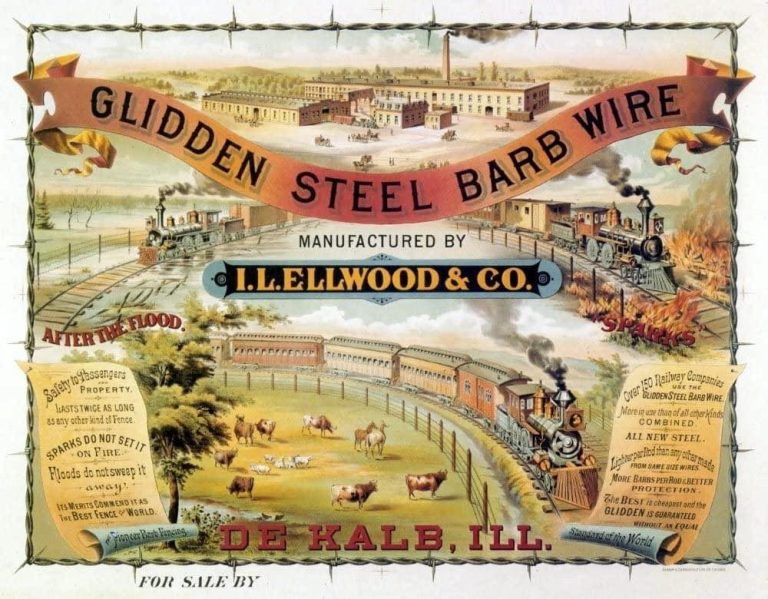Joseph Farwell Glidden's invention of one of the most widely-used types of barbed wire in 1873 helped change the history of the American West and had far-reaching impact throughout the world. His Homestead in DeKalb, IL, is being preserved and restored by a not-for-profit organization founded in 1995. Both the home and the barn are listed on the National Register of Historic Places. We welcome your visit and encourage your membership!
Glidden's "The Winner"
Joseph F. Glidden was granted a patent on November 24, 1874 for "The Winner," what became one of the most-widely used types of barbed wire in the nation. It all began on the Glidden farm, at the time “a mile west of the city of DeKalb.”
Joseph began searching for a better fencing method after his wife, Lucinda, complained about livestock getting into the yard. Lucinda, in her own later recollections, told about her large wire hairpins that began disappearing from a milk-glass dish on her dresser during the winter of 1872-73. She questioned their 20-year-old daughter, Elva Frances, who denied taking them.
The puzzle bothered Lucinda until one evening after supper when she noticed her husband reach in his shirt pocket and take out two of her missing hairpins. "Joseph, what are you doing with my hairpins?" she asked. He replied that he was working on an idea for a fence.
When the weather improved, Joseph purchased a reel of smooth fence wire from Isaac Ellwood's hardware store and began experimenting. At one point, he tried to form a piece of wire into a small coil that would fit reasonably tight on a single strand of wire. After being struck with a hammer, it would tightly clinch around the wire and stay in place.
However, with only pliers as tools, Joseph found it difficult to produce a coil small enough with sufficient uniformity for his needs. He took his problem to his long-time friend and blacksmith Phineas Vaughan. Together, they took apart an old coffee mill and reassembled it, utilizing the principle of a moving sleeve and a lug. With a turn of the crank, the machine produced a small uniform-sized coil.
Joseph Glidden then returned to his experiment of clinching the coils with their tangs and twisting it with another smooth wire on the single strand. Thus, he came to invent the first practical "barbed wire." This barbed wire became the template on which all of the most successful barbed wire designs were based.
The idea of a thorny or barbed wire fence constructed with sharp spines or points to ward off livestock was not then entirely new, according to a history of DeKalb County. Michael Kelly had patented a barbed wire for fencing on November 17, 1868, which was reissued April 4, 1876. But it consisted of a flat wire, with the barbs inserted in holes made through it.
Glidden’s first patent on May 12, 1874, was a decided improvement on the Kelly model. It consisted of a round fence wire and a barb formed of two short, pointed pieces of wire, secured in place upon the fence wire by coiling between their ends, which were extended to present four points in different directions. But on November 24, Glidden patented still another improvement (The Winner), substituting a double twisted wire for the single wire, upon which was fixed a piece of pointed wire coiled in the center, forming two transverse points.
From manufacturing a few of these by hand on his farm, Glidden progressed to making the material by horse-power, using at first a single horse to propel his imperfect machinery, which over the years was improved until "its perfection is a matter of astonishment to all beholders," according to the history of DeKalb County.
"This machinery, together with the extensive establishment, has all been created out of the raw material within the incredibly short period of two years, during which time the large sums of money expended have been made in the business itself; so that it has been self-developing and self-supporting, and has created in addition a large surplus. The secret of its financial success is the fact that it has met a want everywhere urgently felt all over the great prairie country of the West; and the vast territory being of such varied climate that the demand is as great in winter as in summer. At no time during any of the seasons, is there not fencing going on in some portion of the great field in which this fence is demanded--in Illinois or Iowa, in Texas or California," the history reported.
Glidden first convinced his neighbors of the practicability of the invention by making it with his own hands and setting off his farm portions with the fence. As these experiments were gradually improved and exhibited, the demand for the fence became urgent. In July, 1874, Glidden entered into partnership with the young, energetic Isaac L. Ellwood, and commenced manufacturing in the City of DeKalb. The business soon outgrew their facilities and in the winter of 1874-75, they erected a larger building.
In 1876 Glidden “retired” from manufacturing by selling his half of the business to Washburn and Moen, but retained royalties. The Glidden Barbed Wire company evolved into American Steel and Wire and eventually was incorporated into the U.S. Steel Manufacturing Company of today.

© Copyright. All rights reserved.
We need your consent to load the translations
We use a third-party service to translate the website content that may collect data about your activity. Please review the details in the privacy policy and accept the service to view the translations.
